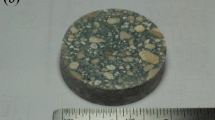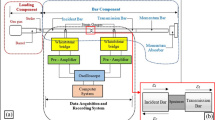Abstract
It is important to consider the effect of size when estimating the ultimate strength of a concrete member under various loading conditions. Well known as the size effect, the strength of a member tends to decrease when its size increases. Therefore, in view of recent increased interest in the size effect of concrete this research focuses on the size effect of two main classes of compressive strength of concrete: pure axial compressive strength and flexural compressive strength.
First, fracture mechanics type size effect on the compressive strength of cylindrical concrete specimens was studied, with the diameter, and the height/diameter ratio considered as the main parameters. Theoretical and statistical analyses were conducted, and a size effect equation was proposed to predict the compressive strength specimens. The proposed equation showed good agreement with the existing test results for concrete cylinders.
Second, the size, length, and depth variations of a flexural compressive member have been studied experimentally. A series of C-shaped specimens subjected to axial compressive load and bending moment were tested. The shape of specimens and the test procedures used were similar to those by Hognestad and others. The test results are curve-fitted using Levenberg-Marquardt’s least squares method (LSM) to obtain parameters for the modified size effect law (MSEL) by Kim and co workers. The results of the analysis show that the effect of specimen size, length, and depth on ultimate strength is significant. Finally, more general parameters for MSEL are suggested.
Similar content being viewed by others
References
Bazant Z P 1984 Size effect in blunt fracture; concrete, rock, metal.J. Eng. Mech., Am. Soc. Civil Eng. 110:518–535
Bazant Z P 1987 Fracture energy of heterogeneous material and similitude.SEM-RILEM Int. Conf. on Fracture of Concrete and Rock (Houston, TX: SEM-RILEM) pp 390–402
Bazant Z P 1989 Identification of strain-softening constitutive relation from uniaxial tests by series coupling model for localization.Cement Concrete Res. 19: 973–977
Bazant Z P 1993a Size effect in tensile and compressive quasibrittle failures.JCI Int. Workshop on Size Effect in Concrete Structures (Sendai: ICI) pp 141–160
Bazant Z P 1993b Size effect in tensile and compressive quasibrittle failure.Proc. Int. Workshop, Size Effect in Concrete Structure, Sendai, Japan (eds) H Mihashi, H Okamura, Z P Bazant (London: Chapman & Hall) pp 161–180
Bazant Z P, Chen E P 1997 Scaling of structural failure.Appl. Mech. Rev., ASME50: 593–627
Bazant Z P, Xi Y 1991 Statistical size effect in quasi-brittle structures: II. Nonlocal theory.J. Eng. Mech., Am. Soc. Civil Eng. 117: 2623–2640
Bazant Z P, Xiang Y 1994 Compression failure of quasibrittle materials and size effect.AMD Symp. Ser. ASME Appl. Mech. Div., 185,Damage Mechanics in Composites, ASME Winter Annual Meeting, Chicago (eds) D H Allen, J W Ju pp 143–148
Bazant Z P, Xiang Y 1997 Size effect in compression fracture: Splitting crack band propagation.J. Eng. Mech., Am. Soc. Civil Eng. 123: 162–172
Bazant Z P, Xi Y, Reid S G 1991 Statistical size effect in quasi-brittle structures: I. Is Weibull theory applicable?J. Eng. Mech., Am. Soc. Civil Eng. 117: 2609–2622
Benjamin J R, Cornell C A 1970Probability, statistics, and decision for civil engineers (New York: McGraw-Hill) sec. 4.3
Blanks R F, McNamara C C 1935 Mass concrete tests in large cylinders.ACI J. Proc. 31: No. 280–303
Cotterell B 1972 Brittle fracture in compression.Int. J. Fracture 8: 195–208
Department of the Interior 1965 Mass Concrete Investigations Bulletin No. 4, Final Report, Boulder Canyon Project-Part VII, Cement and Concrete Investigations, US Bureau of Reclamation
Gonnerman H F 1925 Effect of size and shape of test specimen on compressive strength of concrete.Proc. ASTM. 25: 237–250
Hillerborg A 1988 Fracture mechanics concepts applied to moment capacity and rotational capacity of reinforced beams.Proc. Int. Conf. Fracture and Damage Mechanics of Concrete and Rock, Vienna, pp 233–240
Hognestad E, Hanson N W, McHenry D 1955 Concrete stress distribution in ultimate strength design.ACI J. Proc. 52: 455–479, also PCA Deve. Bull. D6
IMSL Library, Edition 8, IMSL, Inc.
Jansen D C, Shah S P 1997 Effect of length on compressive strain softening of concrete.J. Eng. Mech., Am. Soc. Civil Eng. 123: 25–35
Jenq Y S, Shah S P 1991 Features of mechanics of quasi-brittle crack propagation in concrete.Int. J. Fracture 51: 103–120
Kaar P H, Hanson N W, Capell H T 1977 Stress-strain characteristics of high-strength concrete PCA Research and Development Bulletin RD051.01D, pp 1–10
Kesler C E 1959 Effect of length to diameter ratio on compressive strength-An ASTM cooperative investigation.Proc. ASTM 59: 1216–1229
Kim J K, Eo S H 1990 Size effect in concrete specimens with dissimilar initial cracks.Maga. Concrete Res. 42: 233–238
Kim J K, Eo S H, Park H K 1989 Size effect in concrete structures without initial crack.Fracture mechanics: Application to concrete (Detroit: ACI) SP-118, pp 179–196
Kim J K, Yi S T, Park C K, Eo S H 1999 Size effect on compressive strength of plain and spirally reinforced concrete cylinders.ACI Struct. J. 96: 88–94
Kim J K, Yi S T, Yang E I2000 Size effect on flexural compressive strength of concrete specimens.ACI Struct. J. 97: 291–296
Kim J K, Yi S T, Kim J H J 2001 Effect of specimen sizes on flexural compressive strength of concrete.ACI Struct. J. 98:416–424
Markeset G 1995 A compressive softening model for concrete.Fracture mechanics of concrete structures (ed.) F H Wittmann (FRAMCOS-2, AEDIFICATIO Publishers) pp 435–443
Markeset G, Hillerborg A 1995 Softening of concrete in compression localization and size effects.Cement Concrete Res. 25: 702–708
Murdock J W, Kesler C E 1957 Effect of length to diameter ratio of specimen on the apparent compressive strength of concrete.ASTM Bull. (221) 68–73
Rokugo K, Koyanagi W 1992 Role of compressive fracture energy of concrete on the failure behaviour of reinforced concrete beams.In Applications of Fracture mechanics to reinforced concrete (ed.) A Carpenteri (Elsevier Applied Science) pp 437–464
Smadi M M, Slate F O 1989 Microcracking of high and normal strength concretes under short and long-term loadings.ACI Mater. J. 86: 117–127
Swartz S E, Nikaeen A, Narayan Babu H D Periyakaruppan N, Refai T M E 1985 Structural bending properties of higher strength concrete.High-Strength Concrete SP-87: 147–178
Van Mier J G M 1992 Scaling in tensile and compressive fracture of concrete. InApplications of fracture mechanics to reinforced concrete (ed.) A Carpenteri (Elsevier Applied Science) pp 95–135
Vonk R A 1992Softening of concrete loaded in compression. Ph D thesis, Eindhoven University of Technology, Eindhoven
Author information
Authors and Affiliations
Corresponding author
Rights and permissions
About this article
Cite this article
Kim, JK., Yi, ST. Application of size effect to compressive strength of concrete members. Sadhana 27, 467–484 (2002). https://doi.org/10.1007/BF02706995
Issue Date:
DOI: https://doi.org/10.1007/BF02706995




